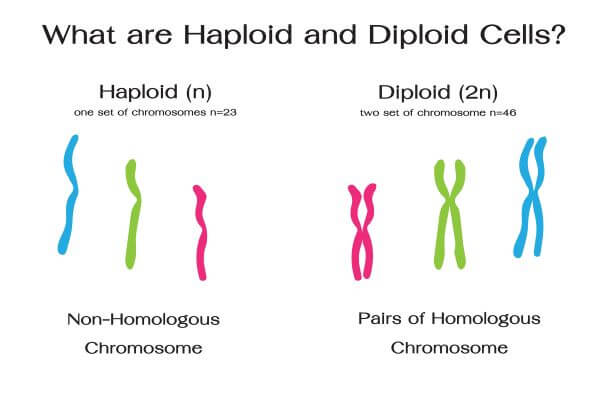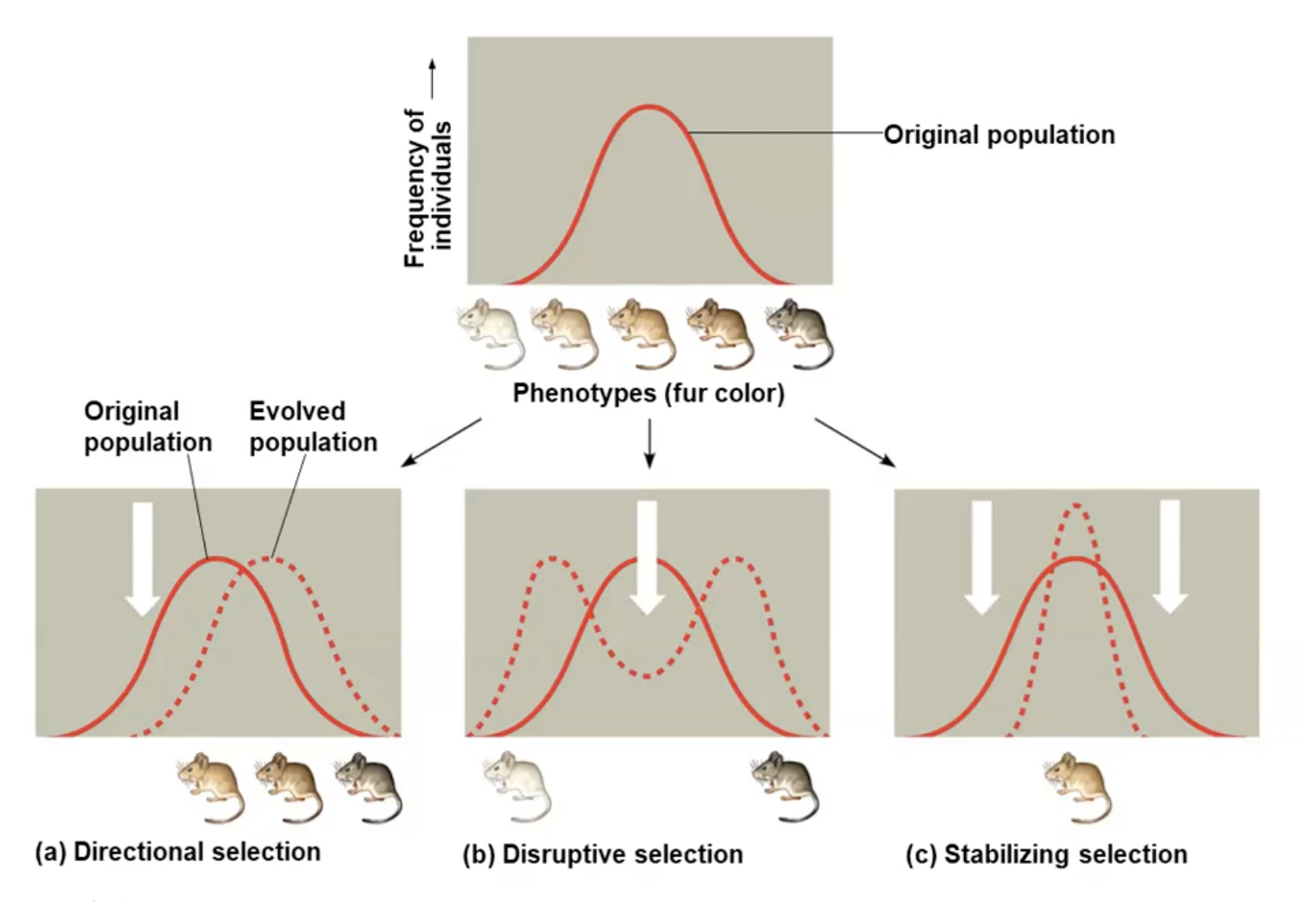Chapter 23
Microevolution — change in allele frequencies in a population over generations
Mechanisms that cause allele frequency change:
Natural selection
genetic drift
gene flow
Only natural selection causes adaptive evolution
Genetic variation among individs. is caused by differences in genes or DNA
In order for evolution to occur there needs to be variation in heritable traits
Phenotype is the combination between inherited genotypes and environmental influences
Natural selection can only act on variation w/ a genetic component
Average heterozygoisty — what percent of individ/genes are likely to have both dominant and recessive
Geographic variation — differences between gene pools of separate populations
Ex: cline — change in a trait geographically
Fish vary in a cold-adaptive allele along a temperature gradient
Due to natural selection
New genes & alleles due to mutations
Only mutations in reproduction cells (gametes) can be passed to offspring
Changes in somatic cells will not be passed along
Mutation rates are low in animals & plants, higher in viruses
Sexual reproduction can shuffle existing alleles into new combinations
Recombination

Makes adaptation possible
Population — localized group of individuals capable of interbreeding & producing fertile offspring
Gene pool — all of the alleles for all loci in a population
Ex: all the lanternflies at GHS!
If every individual in the population are the same, meaning the are homozygous for every same allele —> change is not possible — locus is fixed

Calculating Allele Frequencies using Hardy-Weinberg:
The total number of dominant alleles at a locus is 2 alleles for each homozygous dominant individual plus 1 allele for every heterozygous individual; the same logic applies for recessive alleles
p+q = 1
p = frequency of the dominant allele, q = frequency of the recessive allele
Hardy-Weinberg principle — describes population that is not evolving
If it doesn’t meet the criteria, it is evolving
p²+2pq+q²=1
p² and q² represent the frequencies of the homozygous genotypes & 2pq represents the frequency of the heterozygous genotype
p² is the frequency of the homozygous dominant genotype
q² is the frequency of the homozygous recessive genotype
In real populations, allele & genotype frequencies do change over time. This represents a hypothetical population that is not evolving
Conditions that must be met in order for Hardy-Weinberg equilibrium to hold true:
No mutations
Random mating — no sexual selection
No natural selection
Extremely large population size —> no genetric drift
No gene flow —> no migration
You can have some loci be in Hardy-Weinberg equilibrium while others are not
What causes changes in allele frequencies?
Natural selection
Genetic drift
Seen much more often in smaller populations
Ex: 50 Question test & you miss 1 vs. 5 question test & you miss 1 —> much larger affect
Random changes reduce genetic variation bc of losses of alleles
Gene flow —> migration/immigration
Founder effect — when some individuals become isolated from a larger population, so sometimes the allele frequencies in the small founder population can be different from those in the larger parent population
Ex: some individuals of the population get separated from the parent population mb because of a natural disaster, and they aren’t able to connect with them. They evolve separately and adapt to their new environment. If you were to combine them again they would likely look different
Bottleneck effect — sudden reduction in population size due to a change in the environment
Resulting gene pool may no longer be reflective of the original population’s gene pool
Ex: original population had red, blue, yellow, and green bugs. Bottleneck effect happens/natural disaster —> only red and blue bugs remain, which isn’t reflective of the original population with the other color bugs too. Then the species evolves with red, blue, and maybe purple bugs, but the yellow & green bugs die off.
By chance
Humans can have an impact with bottleneck effect —> understanding how we impact other species
Effects of genetic drift:
Significant in small populations
Causes allele frequencies to change at random
Can lead to a loss of genetic variation within populations
Can cause harmful alleles to become fixed
Gene flow — migration/immigration
Alleles can be transferred through the movement of fertile individuals or gametes
Gene flow tends to reduce variation among populations over time & can reduce the fitness of the population
Evolution by natural selection involves both chance and “sorting”
New genetic variations arise by chance
Beneficial alleles are “sorted” and favored by natural selection
Only natural selection consistently results in adaptive evolution
Relative fitness — contribution an individual makes to the gene pool of the next generation, relative to the contributions of other individuals
“survival of the fittest” is misleading bc it implies direct competition among individs. —> reproduction is usually more subtle and depends on many factors
Selection favors certain genotypes by acting on the phenotypes of certain organisms
Three modes of selection:
Directional selection: favoring one end of the phenotypic range
Disruptive selection: favors both extremes of the phenotypic range
Stabilizing selection: favoring the outlier

Natural selection increases the frequencies of alleles that enhance survival and reproduction
Bc the environment can change, adaptive evolution is a continuous process
Genetic drift & gene flow do not consistently lead to adaptive evolution bc they can increase or decrease the match between an organism & its environment
Selection selection:
Can result in sexual dimorphism — physical differences between genders
Intrasexual selection — competition among one sex (usually males) for mates of the opposite sex
Intersexual selection — mate choice, when individuals of one sex (usually females) are choosy in selecting their mates
Male showiness due to mate choice can increase a male’s chance of attracting a female while decreasing his chances of survival
Female preferences evolve over time, but the
good genes” are related to male health —> both the male trait & female preference for that trait should increase in frequency
Neutral variation — genetic variation that does not have an advantage or disadvantage
Diploidy — genetic variation in the form of hidden recessive alleles
Heterozygotes can carry recessive alleles that are hidden from the effects of selection
Balancing selection — natural selection results in more than 2 phenotypic forms in a population
Includes heterozygote advantage — when heterozygotes have a higher fitness than do both homozygotes
Ex: malaria resistance
Natural selection tends to maintain 2+ alleles at the locus
Frequency-dependent selection: fitness of the phenotype declines if it becomes too common in the population
Selection can favor whichever phenotype is less common in a population
Natural selection can’t make perfect organisms
Selection can act only on existing variations
Evolution is limited by what's already present
Adaptations are compromises
Nothing is static — chance, natural selection, & the environment all work together